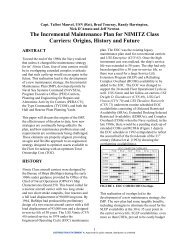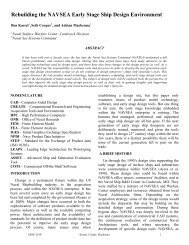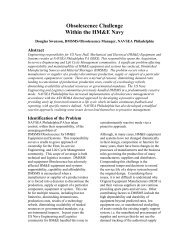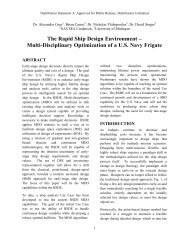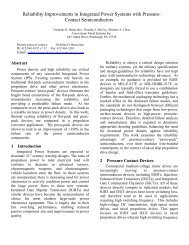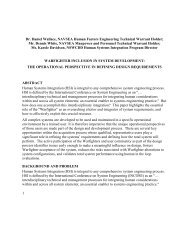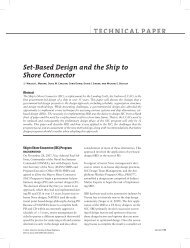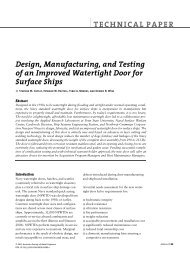The Wreck of DKM Bismarck − A Marine Forensics Analysis 1 The ...
The Wreck of DKM Bismarck − A Marine Forensics Analysis 1 The ...
The Wreck of DKM Bismarck − A Marine Forensics Analysis 1 The ...
Create successful ePaper yourself
Turn your PDF publications into a flip-book with our unique Google optimized e-Paper software.
<strong>The</strong> <strong>Wreck</strong> <strong>of</strong> <strong>DKM</strong> <strong>Bismarck</strong> <strong>−</strong> A <strong>Marine</strong> <strong>Forensics</strong> <strong>Analysis</strong><br />
<strong>The</strong> superstructure decks <strong>of</strong> the forward command tower aft <strong>of</strong> the heavily armored<br />
forward conning tower are missing from the main hull. (<strong>The</strong> missing decks range from the Lower<br />
Bridge Deck to the foretop, including the Admiral’s Bridge and the decks from the fore tower<br />
mast.) <strong>The</strong> failure is believed to be the result <strong>of</strong> shell damage to the lower bridge deck and the<br />
inability <strong>of</strong> the welded connection to resist the impact force <strong>of</strong> the capsizing and subsequent<br />
rotation <strong>of</strong> the hull before and after the plunge. Seaman Statz recalled that a number <strong>of</strong> shells<br />
struck the forward command tower above and below his position on the Upper Bridge Deck.<br />
Welded connections could have been weakened by such shell damage.<br />
This portion <strong>of</strong> the superstructure was found upside down a few meters west <strong>of</strong> the slide<br />
scar, 350 meters north <strong>of</strong> the main hull. It appears to be complete and is at the lower terminus <strong>of</strong><br />
its own small slide scar, evidence <strong>of</strong> the main hull striking it during its slide downhill. <strong>The</strong> port<br />
side windows <strong>of</strong> the Admiral’s bridge are without glass but otherwise intact. Some <strong>of</strong> the access<br />
ladders were torn away or severely damaged during the final battle. Baron von Müllenheim-<br />
Rechberg confirmed this, noting that several men were running around the forward command<br />
tower looking for a route <strong>of</strong> escape during the time before capsizing 35 . It is believed that this<br />
structure, like the main battery turrets, made a direct plunge to the bottom. <strong>The</strong> forward windows<br />
appear to have been damaged by shell hits or fragments, as well as from the impact <strong>of</strong> this<br />
structure with the seabed. <strong>The</strong> windows are heavily overgrown with rusticles 36 , suggesting fire<br />
damage. <strong>The</strong> foretop main battery director cupola and rangefinders are missing. This was<br />
probably shot away by one <strong>of</strong> Norfolk’s early 203-mm shell from King George V at its base<br />
brought it down near the end <strong>of</strong> the engagement.<br />
<strong>The</strong> funnel is missing. It was not found in the debris field, but could have been buried by the<br />
avalanche that preceded the main hull in its slide down the seamount, or it may have<br />
disintegrated in its plunge to the seabed. According to the senior surviving <strong>of</strong>ficer, Baron von<br />
Mǖllenheim-Rechberg, the funnel was heavily holed by shell fire. <strong>The</strong> structure around the<br />
attachment <strong>of</strong> the funnel to the main hull exhibits heavy shell damage. <strong>The</strong> funnel probably was<br />
detached from the ship during the capsizing and subsequent rotations <strong>of</strong> the hull during its<br />
plunge to the bottom.<br />
All three aircraft hangars still exist, but the two forward ones were heavily damaged by<br />
shellfire. <strong>The</strong> doors are missing from all three. Since the aft hangar doors were missing, it was<br />
possible to examine that hangar’s interior. A large piece <strong>of</strong> one <strong>of</strong> the aft hangar doors was found<br />
inside the forward starboard hangar, lying within a very large shell burst hole three meters in<br />
diameter. This hole might have created by a shell hit from Rodney, whose fragments may have<br />
penetrated to one <strong>of</strong> the starboard boiler rooms, as reported by one survivor. One Arado seaplane<br />
was found in the center <strong>of</strong> the aft hangar. Only the front half remains, including the left wing and<br />
float, the radial engine, and propeller. Parts <strong>of</strong> a second Arado were found in the port forward<br />
hangar that was heavily damaged by shell hits. <strong>The</strong>re was a spare propeller found still mounted<br />
on the forward bulkhead.<br />
35<br />
Baron Burkard von Müllenheim-Rechberg. Page 256, Battleship <strong>Bismarck</strong>, A Survivor’s Story.<br />
Annapolis: Naval Institute Press, 1980.<br />
36<br />
Rusticles are bacterial growths that will eventually recycle metal into the environment. <strong>The</strong>y are<br />
discussed later in this paper.<br />
37



